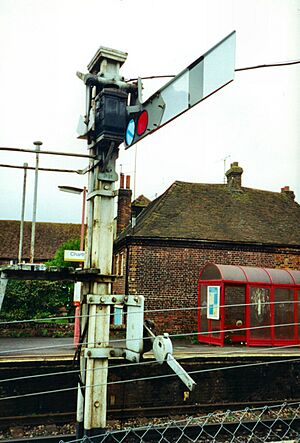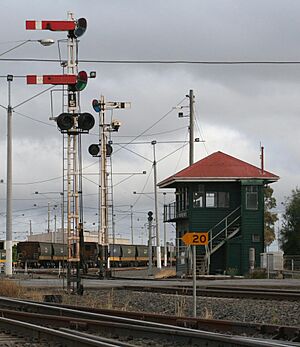Railway semaphore signal facts for kids

A semaphore signal is a special kind of sign used on railway tracks. It's one of the oldest ways to tell train drivers what to do. These signals have a moving arm that changes its angle to give different messages to the trains.
Contents
What are Semaphore Signals?
Semaphore signals are like traffic lights for trains. They use a movable arm, called a 'blade' or 'arm', to show different messages. The arm pivots, meaning it swings up or down, to tell the train driver if it's safe to go, or if they need to stop or slow down.
How Semaphore Signals Work
The position of the signal arm tells the train driver what to do.
- When the arm is straight out (horizontal), it usually means "stop".
- When the arm is angled up or down, it means the track ahead is clear, or that the driver should be careful.
There are two main types of semaphore signals based on how their arm moves:
- Lower Quadrant Signals: The arm moves downwards from the horizontal position to show a "clear" signal.
- Upper Quadrant Signals: The arm moves upwards from the horizontal position to show a "clear" signal. These are more common today.
These signals are often controlled by levers in a signal box. These levers are connected to the signal arms by long wires or rods. When a signal operator pulls a lever, the arm on the signal moves.
Different Kinds of Semaphore Signals
Semaphore signals can also have different jobs:
- Home Signals: These signals tell a train if it can enter a section of track or a station. If the arm is horizontal, the train must stop.
- Distant Signals: These signals are placed further back from a home signal. They warn the driver about the next home signal's position. A distant signal usually has a 'fish-tail' shape on its arm. It can only show "caution" (prepare to stop) or "clear" (proceed). It never tells a train to stop completely.
The History of Railway Signals
Semaphore signals were invented a long time ago, in the early 1800s. The first railway semaphore signal was used in England in 1841. Before these signals, railway workers had to use flags or hand signals to communicate with train drivers. This was not very safe, especially at night or in bad weather.
Semaphore signals made train travel much safer and more organized. They allowed trains to run closer together without crashing. For many years, they were the most common type of railway signal around the world.
Semaphore Signals Today
Even though new technologies like colored light signals are now very common, you can still find semaphore signals in use today. Some older railway lines, especially in parts of the United Kingdom, Australia, and India, still use them. They are a cool reminder of railway history and how trains were controlled for many years.
Images for kids
-
Upper quadrant signal on the Santa Fe Railroad, 1943. The vertical position indicates a "clear" aspect.
-
Lower quadrant stop signals at St. Erth in 2007
-
Signals on the River Weaver Navigation, directing boats into the paired locks
See also
 In Spanish: Semáforo ferroviario para niños
In Spanish: Semáforo ferroviario para niños









